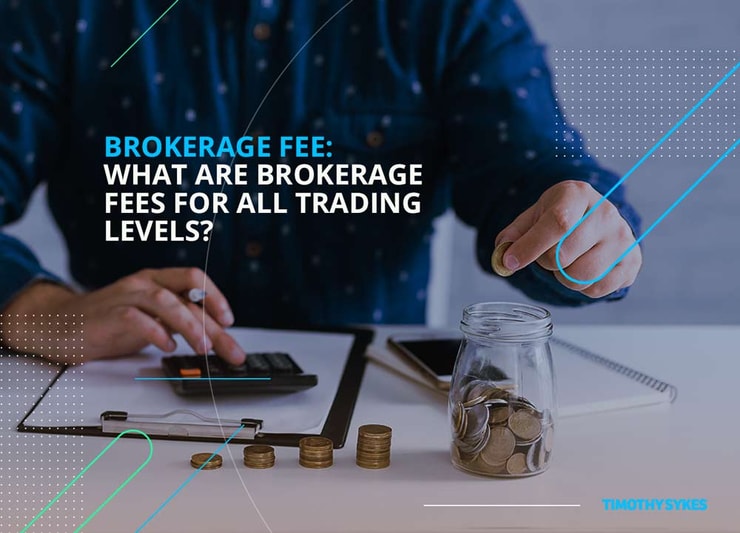As an investor, it’s important to understand brokerage fee for all trading levels so that you can maximize your earning potential. Here, I’ll offer a comprehensive overview on the different types of brokerage fees so that you can have a better idea of how to choose the right broker to suit your needs.
It’s not hard to get started as a trader — all you need is a laptop or mobile device, an internet connection, and a brokerage account.
A device and getting connected are pretty self explanatory, but finding the right brokerage account can prove a little bit trickier.
Brokerage fee and commissions can eat away at your bottom line, making it hard to get ahead financially. As an investor, it’s important to understand brokerage fees for all trading levels to help you maximize your earning potential.
Here, I’ll offer a comprehensive overview on the different types of brokerage fees so that you can have a better idea of how to choose the right broker to suit your needs.
Table of Contents
What is a Brokerage Fee?

2025 Millionaire Media, LLCA brokerage fee is an amount charged by a licensed broker to execute transactions or to provide financial services.
Brokerage fees exist across a variety of industries, from real estate to mortgage to insurance. The percentage of the commission or amount of the fee will vary depending on the service and the industry.
For an investor in the stock market, the common brokerage fees are typically associated with executing trades or financial advisement.
As a trader, you’ll encounter three primary types of brokers: full service, discount, and online brokers.
The Importance of Choosing a Cost-Effective Broker
Not all brokers are the same, and no two fee structures are identical. Because they can vary quite widely, it’s extremely important to do a brokerage fee comparison.
Why? Several reasons.
For one, the expense of these fees can add up and can have an effect on your returns. Say that your portfolio is up 10 percent for the year … awesome, right? But then when you consider that you’ve paid 1.5% in fees, your return is actually just 8.5%. Still good, but not quite as awesome.
For another, you may be surprised to learn that some of the fees aren’t obvious. There might be an advertised rate or percentage that seems quite favorable, but there can be hidden fees associated with your account.
These might include a fee for maintaining a certain balance or a fee for closing your account. It’s good to know about fees like this from the beginning rather than being unpleasantly surprised later.
I should also state for the record that cheaper/lower fees aren’t always better. You truly need to consider your goals when looking at brokers. Sometimes, if they are able to give you exactly what you need, it may be worth paying a little bit more in fees.
How Much Do Brokers Charge?

2025 Millionaire Media, LLCAs I mentioned, every broker will charge a different brokerage fee. However, we can look at several brokers to illustrate examples of the potential fees/commissions:
Average Brokerage Fee
Let’s look at some of the big guys to get a general read on average broker fees.
At the time of this writing, TD Ameritrade and E-Trade have commission fees of $6.95 per trade (buying or selling).
These are both platforms that I use, and they both have similar offerings and interfaces.
More Breaking News
- DNN Stocks on the Rise: What’s Next?
- GRAB’s Unexpected Surge: Time to Reevaluate?
- Momentus Inc. Facing a Critical Trend Shift?
Trade Commissions
Rather than a per-trade fee, some brokers have trade commissions or different pricing structures.
A platform like Interactive Brokers can be good for trading on margin (I don’t recommend it, but every trader is different), and they have significant assets.
Their pricing structure can be confusing at first, but it’s not too hard to get used to over time.
Per their website, for stocks, ETFs, and warrants, they can charge “a fixed amount per share or a set percent of trade value, and includes all IB commissions, exchange and most regulatory fees with the exception of the transaction fees, which are passed through on all stock sales.”
Depending on the trade, this can be advantageous. However, consider that there’s a significant buy-in here. Interactive Brokers requires a $10,000 minimum deposit to get started, and you have to keep a balance of at least $2,000 in your account at all times.
Mutual Fund Transaction Fees
Different types of investments may come with different pricing structures. Mutual funds are one such example.
Mutual funds are not the same as stocks. They’re more like an investment salad. A mutual fund is a melange of stocks, bonds, and other investments all bundled together.
When you buy a mutual fund, you don’t own shares of the stocks or bonds yourself, but rather shares of the mutual fund. As the overall value of the investments goes up or down, the value of the mutual fund shares follow in kind.
One of the benefits of investing in a mutual fund is that it gives you instant diversification, which can balance out the risk — if one asset goes down, another one might go up, ideally keeping the universe (and your investment) in balance.
If you’re interested in mutual funds, be sure to look closely at the broker’s offerings. First, make sure to check that they even offer them. Some brokers don’t offer mutual funds at all.
If they do offer mutual funds, the next step is to look at the fee structure.
If it’s called an NTF, that’s a good thing. It means ‘no transaction fee,’ and you won’t be charged to trade. However, you might be subject to an early redemption fee if you sell too soon, so be sure to check that out.
Typically, online brokers offer better deals for mutual funds. This is worth noting because fees can be significant, ranging from the NTF noted above or up to $76 via Charles Schwab, as of the time of this writing.
Expense Ratios
Managing a fund doesn’t always come cheap. There’s a little something called the MER (management expense ratio) that you should research before buying into a fund. The MER is how much of the fund’s assets are allocated to operating and overall expenses.
This is something well worth exploring because these charges might not be immediately evident. They don’t show up as a charge on your statement; rather, they are reflected in the NAV (net asset value).
The operating expenses have the effect of overall reducing the assets in the fund, which means that your returns will be lower.
Components of an Expense Ratio

2025 Millionaire Media, LLCAdmin fees sounds kind of vague, right? So let’s break down the components of an expense ratio.
The expense ratio includes how much the investment manager/advisor is paid, and expenses like accounting, taxes, legal expenses, and record keeping.
Additionally, it could include promotional fees. If you see something called a 12b-1 fee listed, it’s referring to a promo fee. There’s a cap on this, though — FINRA has a rule that these fees can’t exceed 1%.
The expenses can vary from fund to fund, but within each fund, they remain stable. So, for instance, if a fund has a fee of 0.6%, that fee will remain fixed.
What an expense ratio does not include is the actual fund activity. So this means that costs that would not be included in the operating expenses listed would be contingent on deferred sales charges (also referred to as CDSC), loads, and redemption fees. These would have to be paid directly by you as fees.
Sales Loads
A sales load is a charge for the purchase or sales of shares of a fund, which acts as the fee/commision. Usually it’s a percentage. According to the SEC, the highest sales load allowed is 8.5%.
There are different types of sales loads associated with funds. Here are some of the key types.
Front-end load: This is when the charges occur upon buying shares of a mutual fund. It’s usually a commission to the broker who sells the fund shares.
The fee will come off of the top of the amount that you invest. For example: Say that the front-end load is 5% and you’ve decided to invest $2,000. This means that your actual investment will be $100 less, minus the commission.
Back-end load: This is when the fee is charged upon selling shares of a mutual fund. It’s usually a commission that goes to the broker who sells the fund shares.
Usually, a back-end load percentage starts at about 5 percent, but it usually declines with each year that you hold on to the shares.
The rate of reduction is detailed in the fund prospectus or marketing materials. It’s possible for the fee to be totally erased if you hold on to the shares long enough.
Level load/low load: A level or low load is like a back-end load in that you don’t pay a fee when you purchase shares, but rather when sold.
The key difference between these types of loads and the traditional back-end load is that it has a shorter time frame where the fees might be charged.
No-load fund: This means that there is no sales load commission fee associated with the fund. However, it doesn’t necessarily mean there are no fees associated with it.
There still can be account fees, purchase fees, or redemption fees. Often, these types of funds can have higher expense charges annually.
Management or Advisory Fees
Sometimes, brokers will charge management or advisory fees.
These might include portfolio management, or any other admin fees to the advisor or affiliates. These fees might be called maintenance fees. Here are some that you might encounter:
401(k) Fees
A 401(k) is a retirement savings account that’s sponsored by your employer. This plan lets you save a portion of your paycheck before taxes are taken out, which you can then invest. The taxes on a 401(k) aren’t charged until the money is taken out of the account.
The fees on a 401(k) are typically pretty low. A large plan might have a fee at or below 1%, but some plans can have fees that are 3% or higher.
How the fees are charged can vary. Sometimes they are deducted from your investment returns, whereas others are deducted from the assets themselves, and yet others are paid for by the employer.
If you have a 401(k), be sure to find out which fee structure applies to yours.
Types of Stock Broker Fees

2025 Millionaire Media, LLCMore fees. Ugh. There are other types of stock broker fees that you might come across as a trader. Here are some additional fee types you should look out for:
Options Trading Fees
If you love trading options, I’ve got bad news: options trading commissions can be kind of confusing. This means it’s super important to understand them before you embark on this type of trading. Here’s the 411:
Options trading base fee: If you’re using an online broker to trade options, there’s usually a per-transaction fee. Sometimes, there’s also a base fee as well. Usually, if they don’t charge a base fee, they like to advertise this fact.
Per contract fee: Plenty of online brokers charge a commission fee per individual options contract. Sometimes, it’s a straightforward fee; other times, it’s a tiered system based on how many contracts you trade.
Exercise fee: With options, you have, well, the option to either execute or exercise the option or to decide not to. This is one of the advantages of this type of trading.
However, some brokers will actually charge a fee if you do decide to exercise. So if you decide to buy (with a call option) or sell (with a put option), you might be charged an exercise fee.
Assignment fees: If you’ve set up the option to automatically buy or sell, you could also be charged an assignment fee.
Retirement Services Fees
When it comes to retirement service fees, there are plenty of sneaky fees to look out for. Here are some of the common ones that you may or may not know about:
IRA annual fee: Yes, your IRA may have a yearly fee. It’s not a very common thing, but it does exist. Be sure to check what the deal is with your broker before you open your IRA account. Every dollar counts!
IRA closure fee: Even though it may be a long way off, think about what will happen when you close your IRA account from the get-go.
Be sure to ask about any fees associated with closing your account. Once again, this isn’t common, but it does exist.
Also be sure to ask about transfer fees, because sometimes if you switch brokers, you may be charged a fee. However, often enough, the new broker is willing to pay for these associated costs in return for you bringing them new business.
No fee IRA: This one’s pretty easy to grasp. If a broker doesn’t charge annual maintenance fees for an IRA, they’re considered a “no-fee IRA.”
Banking Services
Your bank account is going to be involved in your brokerage account in some way. Either you’ll deposit funds from your bank account, or you’ll have a bank account with the same company.
Having your bank account with the brokerage company is handy, because then you can write checks right from the brokerage account. Since the two are tethered, transfers will be pretty instant.
If your bank account is through a different bank, be wary of deposit or withdrawal fees. They might not be overt. Or, there may be a cap on how many you can perform per month, after which you’ll be charged.
Account Closing Fee
Not only do I always advocate having an exit strategy and a plan for your trades, but I also suggest having one for your accounts, too.
Be sure to research any fees associated with closing or transferring your account before you even open it.
For instance, if you decide to switch brokers, you may be unpleasantly surprised by a transfer fee. Sometimes, these can be in the range of $100. But don’t just think that you can leave an account inactive, either — you might be charged an inactivity fee.
Some brokerages also charge you a fee to close your account. In some cases, like with E-Trade, you’ll only be charged a nominal fee if you close your account within three months of opening it. However, others might charge as much as $50 to close your account. Know this before you get in.
Examples of Inexpensive Brokerage Accounts

2025 Millionaire Media, LLCIf you’re looking for characteristics of a low-priced brokerage account, here are some things to look for …
Trading Platforms With No Minimum Deposit
One of the first things to look for if you want to minimize brokerage fee is the required minimum deposit.
For instance, some platforms don’t require a minimum deposit, whereas others could require a $10,000 minimum!
Lowest Brokerage Fees
Look at the fee structure for the brokerage in question before you commit.
One example of a low brokerage fee structure is Robinhood.
Per their website, “Robinhood’s mission is to democratize access to the American financial system. We’re an investing platform that lets you buy and sell stocks, exchange-traded funds, options, and cryptocurrencies, all commission free.”
Most brokers will have a page which lists their fee structure. If you’re in doubt, Google fee schedules for any broker you choose, and you should come up with the information fairly quickly.
Essential Broker Services for Traders
Don’t just look at the commissions and fees — look at the big picture. Look for these features in a brokerage to find the best fit for your investment needs:
Graphs and Technical Analysis
What kind of charting and technical analysis tools does the broker offer, if any?
For instance, platforms like E-Trade or TD Ameritrade do charge fees per trade, but they offer pretty good programs for monitoring stocks, so there’s value in these services that may make it worth your while.
Filters
Filters are also important for traders. This can help refine the charts and sectors you’re monitoring. Similar to filtering on Amazon by product or style, you can do this with stocks, on a variety of criteria.
If a broker offers a great platform that offers the ability to filter and sift through stocks, this can be an invaluable tool for helping you choose stocks to trade.
Improve Your Results with Profitable Patterns
As I often say, I’m really just a glorified history teacher.
I’m not necessarily looking for stocks offered from companies that are going to change the world. I look for reliable and predictable patterns in the performance of those stocks that will allow me to profit.**
Of course, I’d be remiss if I didn’t mention my favorite platform for charting and monitoring stocks to find patterns: StocksToTrade.
This amazing platform offers analysis, charts aplenty, and lots of filters so you can create watch lists, identify sectors, and improve your results by keeping track of these patterns over time.
StocksToTrade isn’t an online broker (at least, not yet), but it’s a great tool to help you improve your trading through charts, technical analysis tools, filters, and paper trading.
Trading Challenge
The world of trading has an easy entry. It’s unfortunately also easy to blow up your account, because it’s hard to get up to speed with the conflicting information out there.
I created my Trading Challenge to help enable aspiring traders cut through the bullshit. I want to teach you the skills you need to forge a long-term, sustainable career as a trader.
Yes, this includes plenty of video lessons, webinars, blog posts, and other resources. But most importantly, it’s a live education that you can immerse yourself in while you jump into actual live trading.
I’m trading right along with my students, with a small account. This allows me to stay current and on the same level so that I can impart the best knowledge to you.
The Bottom Line

2025 Millionaire Media, LLCAs an investor, it’s vital to understand the brokerage fees for all trading levels. After all, this can have a huge impact on your earnings over time.
Be sure to do plenty of research into fees and commissions before settling on a broker. Ideally, you want to find a broker who can offer all of the services you want and need, but won’t gouge you left and right with hidden fees and commissions.
Have you researched your broker’s fees?










Leave a reply